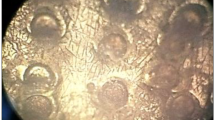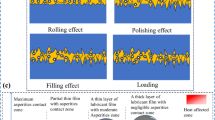Abstract
Hobbing process is one of the machining methods in manufacturing spur gears. In machining processes, selecting a suitable lubricant is one of the significant factors in enhancing machining productivity and improving the characteristics of manufactured workpieces. This study has used the nanolubricant including alumina nanoparticles dispersed in mineral-based oil 25W-50 in hobbing process. Then, hobbing process using the lubricant including both nanoparticles, and none has been done utilizing with the similar hob tools. Two spur gears with DIN1.7131 material have been manufactured using each of two lubricants. Then, the hob tool wear and surface roughness values of manufactured spur gears were investigated. Comparing the results show that using lubricant including alumina nanoparticles in hobbing process causes an expressive decrease in the hob tool crater and flank wear. Also, arithmetic surface roughness value in spur gears manufactured with nanolubricant has decreased.
Similar content being viewed by others
References
Khalilpourazary S, Dadvand A, Azdast T, Sadeghi MH (2011) Design and manufacturing of a straight bevel gear in hot precision forging process using finite volume method and CAD/CAE technology. Int J Adv Manuf Technol 56:87–95. doi:10.1007/s00170-011-3159-z
Radzevich SP (2012) Dudley’s handbook of practical gear design and manufacture. CRC, Boca Raton
Xia YQ, Wang L, Wang XB (2007) Application of synthetic lubricants in gear transmission. J Shenyang Univ Technol 29:484–487. doi:10.3969/j.issn.1000-1646.2007.05.002
Bakunin VN, Suslov AY, Kuzmina GN, Parenago OP (2005) Recent achievements in the synthesis and application of inorganic nanoparticles as lubricant components. J Lubr Sci 17:127–145. doi:10.1002/ls.3010170202
De Barros MI, Bouchet J, Raoult I, Le Mogne T, Martin JM, Kasrai M, Yamada Y (2003) Friction reduction by metal sulfides in boundary lubrication studied by XPS and XANES analysis. Wear 254:863–870. doi:10.1016/S0043-1648(03)00237-0
Srikant RR, Rao DN, Subrahmanyam MS, Krishna VP (2009) Applicability of cutting fluids with nanoparticle inclusion as coolants in machining. Proc Instn Mech Engrs, Part J: J Eng Tribol 223:221–225. doi:10.1243/13506501JET463
Nouailhat A (2010) An introduction to nano science and nanotechnology. Wiley, Wiltshire
Prabhu S, Vinayagam BK (2012) AFM investigation in grinding process with nano fluids using Taguchi analysis. Int J Adv Manuf Technol 60:149–160. doi:10.1007/s00170-011-3599-5
Sayuti M, Sarhan AA, Salem S (2013) Development of SiO2 nano lubrication system for better surface quality, more power savings and less oil consumption in hard turning of hardened steel AISI4140. Adv Mater Res 748:56–60. doi:10.4028/www.scientific.net/AMR.748.56
Sayuti M, Sarhan AA, Tanaka T, Hamdi M, Saito Y (2013) Cutting force reduction and surface quality improvement in machining of aerospace duralumin AL-2017-T4 using carbon onion nano lubrication system. Int J Adv Manuf Technol 65:1493–1500. doi:10.1007/s00170-012-4273-2
Eastman JA, Choi US, Li S, Thompson LJ, Lee S (1997) Enhanced thermal conductivity through the development of nanofluids. Mater Res Soc Symp Proc 457:3–11. doi:10.1557/PROC-457-3
Wang XQ, Mujumdar AS (2007) Heat transfer characteristics of nanofluids: a review. Int J Thermal Sci 46:1–19. doi:10.1016/j.ijthermalsci.2006.06.010, doi: 10.1016%2Fj.ijthermalsci.2006.06.010
Lee S, Choi SUS, Li S, Eastman JA (1999) Measuring thermal conductivity of fluids containing oxide nanoparticles. J Heat Tran 121:280–289. doi:10.1115/1.2825978
Vasu V, Reddy GPK (2011) Effect of minimum quantity lubrication with Al2O3 nanoparticles on surface roughness, tool wear and temperature dissipation in machining Inconel 600 alloy. Proc Inst Mech Eng N J Nanoeng Nanosys 225:3–16. doi:10.1177/1740349911427520
Kutz M (2002) Handbook of materials selection. Wiley, New York
Rozita Y, Brydson R, Scott AJ (2010) An investigation of commercial gamma-Al2O3 nanoparticles. J Phys Conf Ser 241:1–5. doi:10.1088/1742-6596/241/1/012096
Jiao D, Zheng S, Wang Y, Guan R, Cao B (2011) The tribology properties of alumina/silica composite nanoparticles as lubricant additives. Appl Surf Sci 257:5720–5725. doi:10.1016/j.apsusc.2011.01.084
Rapoport L, Leshchinsky V, Lvovsky M, Lapsker I, Volovik Y, Feldman Y, Popovitz-Biro R, Tenne R (2003) Superior tribological properties of powder materials with solid lubricant nanoparticles. Wear 255:794–800. doi:10.1016/S0043-1648 (03)00285-0
Razavi Hesabi Z, Hafizpour HR, Simchi A (2007) An investigation on the compressibility of aluminum/nano-alumina composite powder prepared by blending and mechanical milling. Mater Sci Eng A 454–455:89–98. doi:10.1016/j.msea.2006.11.129
Zhang LL, Tu JP, Wu HM, Yang YZ (2007) WS2 nano rods prepared by self-transformation process and their tribological properties as additive in base oil. Mater Sci Eng A 454–455:487–491. doi:10.1016/j.msea.2006.11.072
Gerth J, Werner M, Larsson M, Wiklund U (2009) Reproducing wear mechanisms in gear hobbing-evaluation of a single insert milling test. Wear 276:2257–2268. doi:10.1016/j.wear.2009.04.004, doi: 10.1016/j.wear.2009.04.004#, link to the full text in the original publication. Subscription is usually required for access
Bouzakis KD, Kombogiannis S, Antoniadis A, Vidakis N (2001) Gear hobbing cutting process simulation and tool wear prediction models. J Manuf Sci Eng 124:42–51. doi:10.1115/1.1430236
Diserens M, Patscheider J, Lévyb F (1998) Improving the properties of titanium nitride by incorporation of silicon. Surf Coat Technol 108–109:241–246. doi:10.1016/S0257-8972 (98)00560-X
Claudin C, Rech J (2009) Development of a new rapid characterization method of hob’s wear resistance in gear manufacturing-application to the evaluation of various cutting edge preparations in high speed dry gear hobbing. J Mater Process Technol 209:5152–5160. doi:10.1016/j.jmatprotec.2009.02.014
Yu W, Choi SUS (2004) The role of interfacial layers in the enhanced thermal conductivity of nanofluids: a renovated Hamilton–Crosser model. J Nanopart Res 6:355–361. doi:10.1007/s11051-004-2601-7
Gerth J, Larsson M, Wiklund U, Riddar F, Hogmark S (2009) On the wear of PVD-coated HSS hobs in dry gear cutting. Wear 266:444–452. doi:10.1016/j.wear.2008.04.014, doi: 10.1016/j.wear.2008.04.014#, link to the full text in the original publication. Subscription is usually required for access
Author information
Authors and Affiliations
Corresponding author
Rights and permissions
About this article
Cite this article
Khalilpourazary, S., Meshkat, S.S. Investigation of the effects of alumina nanoparticles on spur gear surface roughness and hob tool wear in hobbing process. Int J Adv Manuf Technol 71, 1599–1610 (2014). https://doi.org/10.1007/s00170-013-5591-8
Received:
Accepted:
Published:
Issue Date:
DOI: https://doi.org/10.1007/s00170-013-5591-8




